The Jet Propulsion Laboratory – A Brief History
The Jet Propulsion Laboratory, more commonly known as JPL, is a United States federal research center and NASA field center located in the San Gabriel Valley of California. The laboratory’s primary function is the construction and operation of robotic planetary spacecraft, although it also conducts research in a variety of other fields such as astrophysics, earth science, and technology development.
JPL was founded in 1936 by Theodore von Kármán and his student Frank Malina as the Guggenheim Aeronautical Laboratory at Pasadena’s California Institute of Technology (Caltech). Von Kármán had been appointed the institute’s first director back in 1930. The laboratory took on its current name in 1941, when it became part of the National Advisory Committee for Aeronautics (NACA), which later became NASA.
Today, JPL is managed by Caltech for NASA under a contract that was last renewed in 2016. The current director is Michael Watkins. Roughly 5,000 staff members work at the laboratory, which has an annual budget of about $2 billion.
Notable Missions and Discoveries
Since its inception, JPL has been involved in some of NASA’s most notable missions and discoveries. For example, JPL designed and built America’s first interplanetary spacecraft—the Explorer 1 satellite—which discovered Earth’s Van Allen radiation belts in 1958. JPL also played a key role in the Mariner missions to Venus, Mars, and Mercury; the Viking missions to Mars; the Voyager missions to Jupiter, Saturn, Uranus, Neptune; and the Galileo mission to Jupiter.
In recent years, JPL has been involved in such high-profile missions as the Mars rovers Spirit and Opportunity; the Cassini-Huygens mission to Saturn; the Galaxy Evolution Explorer (GALEX); the Dawn mission to Vesta and Ceres; the Kepler mission to search for exoplanets; and currently, the Juno mission to Jupiter.
JPL has also made several important discoveries independently of NASA missions. For example, astronomers working at JPL discovered evidence of water on Mars in 1971. In 2010, they also helped confirm the existence of dark energy—a mysterious repulsive force that appears to be accelerating the expansion of our universe.
JPL is also home to a number of technology demonstration projects—such as autonomous vehicles and microsatellites—that have potential civilian applications.
JPL boasts an impressive resume of accomplishments over its more than 80 years of operation. It has played a role in some of NASA’s most important missions and discoveries and continues to be at the forefront of space exploration with its cutting-edge technology demonstrations. If you’re ever in Southern California, be sure to check out one of America’s premier research laboratories!

